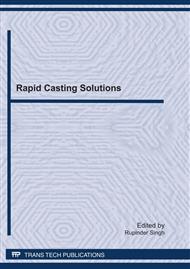p.1
p.9
p.15
p.21
p.31
p.43
p.61
p.77
Experimental Investigations for Silicon Moulding Solution of Plastic Components
Abstract:
The purpose of the present study is to experimentally investigate rapid moulding solutions for plastic components using silicon moulding technique. Starting from the identification of component, prototypes with two different type of plastic material were prepared under different vacuum moulding conditions. Measurements on the coordinate measuring machine helped in calculating the dimensional tolerances of the plastic components produced. Some important mechanical properties were also compared to verify the suitability of the components. The study highlighted the best settings of orientation and type of plastic material for the selected component from dimensional accuracy and economic point of view as rapid moulding solution for plastic components. Final components produced are acceptable as per IS standard UNIEN20286-I (1995). This process ensures rapid production of pre-series technological prototypes and proof of concept at less production cost and time.
Info:
Periodical:
Pages:
9-13
Citation:
Online since:
October 2011
Authors:
Price:
Сopyright:
© 2012 Trans Tech Publications Ltd. All Rights Reserved
Share:
Citation:


